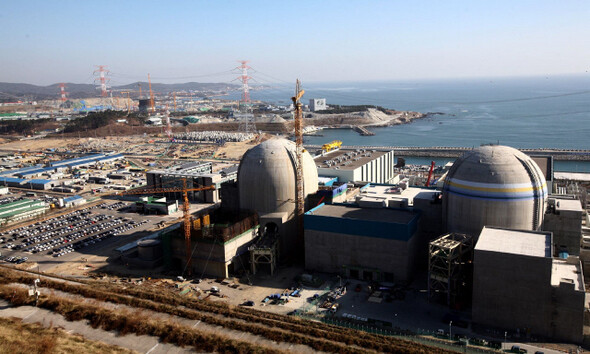hankyoreh
Links to other country sites 다른 나라 사이트 링크
Nuclear export to the Mid. East is the background of battle in Miryang

By Lee Seung-jun, staff reporter
Controversy is flaring up over remarks from the Korea Electric Power Corporation (KEPCO) vice president suggesting that the construction of transmission towers in Miryang, South Gyeongsang Province, has to do with a nuclear power export contract with the United Arab Emirates.
Critics blasted the government for ignoring resident protests and going ahead with the project to satisfy the terms of the contract after claiming it was intended to address a power shortage at home.
The controversy erupted after KEPCO vice president Byun Jun-yeon told reporters on May 23 that the transmission tower situation in Miryang “has to be resolved because the third reactor at the new Kori nuclear power plant was our reference model when exporting nuclear power plants to the UAE.”
“The contract says we have to pay a penalty if the third reactor is not up and running by 2015,” Byun said at the time.
Officials with KEPCO and the Ministry of Trade, Industry and Energy had previously said the towers had to be built in Miryang because of a shortage of power during the winter. The argument was that this shortfall could only be addressed by supplying power from the third new Kori reactor in Busan, which goes on line at the end of December.
But Byun’s statement suggests a different rationale. His remarks appear to be an admission that the point of the towers’ construction is less to address the power shortage and more to meet the terms of the UAE export contract.
The third new Kori reactor is an APR 1400, a new Korean-model pressurized water reactor that is identical to the one exported to the UAE in 2009. A provision in the contract that year required the payment of 0.25% in monthly construction costs as compensation if the reactor was not running by 2015.
Government officials, including Vice Minister of Trade Han Jin-hyun, previously said the construction had to be finished quickly because of a promise to show the UAE a normally functioning reactor. Touted as a major coup by former President Lee Myung-bak, the UAE nuclear power export order was valued at US$40 billion.
Now, with a KEPCO official saying the controversial tower construction is related to the order rather than a need for power in the winter, environmental groups and an association of Miryang residents are harshly criticizing the government.
The association, called the Committee to Oppose the 765 kV Transmission Towers in Miryang, released a statement saying that residents “were dismayed, dispirited, and enraged to hear that the transmission towers are being built in Miryang to avoid paying a penalty on the UAE export order.”
The Green Party also released a statement, in which it demanded that KEPCO “immediately disclose the truth about the UAE nuclear power export issue and the construction of the transmission towers in Miryang.”
A KEPCO official reiterated the position that there was “no direct link” between the order and the towers’ construction.
“The towers are being built because of an electricity shortage,” the official said.
Meanwhile, Byun, the one whose remarks touched off the controversy, submitted his resignation on May 24. He had made additional controversial remarks the day before, saying that residents opposing the construction had been “brainwashed by certain groups.”
Please direct questions or comments to [english@hani.co.kr]

Editorial・opinion
![[Editorial] Intensifying US-China rivalry means Seoul must address uncertainty with Beijing sooner than later [Editorial] Intensifying US-China rivalry means Seoul must address uncertainty with Beijing sooner than later](https://flexible.img.hani.co.kr/flexible/normal/500/300/imgdb/original/2024/0517/8117159322045222.jpg) [Editorial] Intensifying US-China rivalry means Seoul must address uncertainty with Beijing sooner than later
[Editorial] Intensifying US-China rivalry means Seoul must address uncertainty with Beijing sooner than later![[Column] When ‘fairness’ means hate and violence [Column] When ‘fairness’ means hate and violence](https://flexible.img.hani.co.kr/flexible/normal/500/300/imgdb/original/2024/0516/7417158465908824.jpg) [Column] When ‘fairness’ means hate and violence
[Column] When ‘fairness’ means hate and violence- [Editorial] Yoon must stop abusing authority to shield himself from investigation
- [Column] US troop withdrawal from Korea could be the Acheson Line all over
- [Column] How to win back readers who’ve turned to YouTube for news
- [Column] Welcome to the president’s pity party
- [Editorial] Korea must respond firmly to Japan’s attempt to usurp Line
- [Editorial] Transfers of prosecutors investigating Korea’s first lady send chilling message
- [Column] Will Seoul’s ties with Moscow really recover on their own?
- [Column] Samsung’s ‘lost decade’ and Lee Jae-yong’s mismatched chopsticks
Most viewed articles
- 1[Editorial] Transfers of prosecutors investigating Korea’s first lady send chilling message
- 2For new generation of Chinese artists, discontent is disobedience
- 3S. Korea “monitoring developments” after report of secret Chinese police station in Seoul
- 4Xi, Putin ‘oppose acts of military intimidation’ against N. Korea by US in joint statement
- 5[Exclusive] Unearthed memo suggests Gwangju Uprising missing may have been cremated
- 6N. Korean media upgrades epithet for leader’s daughter from “beloved” to “respected”
- 7Yoon says concern about biased diplomacy is being incited by “communist totalitarian forces”
- 8[Editorial] Intensifying US-China rivalry means Seoul must address uncertainty with Beijing sooner t
- 9[Column] Samsung’s ‘lost decade’ and Lee Jae-yong’s mismatched chopsticks
- 10[Special reportage- part I] Elderly prostitution at Jongmyo Park